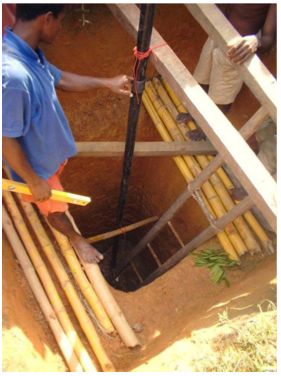Difference between revisions of "Water Portal / Rainwater Harvesting / Groundwater recharge / Infiltration wells"
(→Suitable conditions) |
(→Acknowledgements) |
||
| Line 40: | Line 40: | ||
==Acknowledgements== | ==Acknowledgements== | ||
| + | * CARE Nederland, ''Desk Study Resilient WASH systems in drought prone areas''. October 2010. | ||
Revision as of 00:40, 8 April 2012
These are shallow wells which draw water from a natural aquifer outside of a riverbed, but which have a partial lining. They are useful where recharge of the aquifer is low due to low rock/soil permeability.
Contents
Suitable conditions
- Site where water table is within 5 metres of ground surface, and where soils are stable.
- Site where water demand is low (e.g. for small communities).
Avoid contamination
Site wells at a sufficient distance away from sources of contamination. For microbiological contamination, the distance from the source of contamination (e.g. latrine) to the water intake (screen) needs to be sufficient so as to pose a “low” to “very low” risk – this translates into a minimum of 25 days of potential travel of pathogens in the ground. Travel time is influenced by porosity, hydraulic conductivity (permeability), and hydraulic gradient.
For medium size sand with an average porosity, the distance equivalent to 25 days is around 30 metres, but this can increase to over 100 metres for coarser sediments. However, the distance from contamination to water intake can reduce significantly where the screen intake is at a sufficient depth – this is due to greater variation of aquifer properties in vertical directions than lateral, meaning that a borehole with handpump could be placed very close to a latrine with low risk. However, screen depth must increase with increased extraction rate.
| Advantages | Disadvantages/limitations |
|---|---|
| - Lower cost than making a fully lined well due to less lining needed - Speedier construction compared to fully lined well |
- Cannot easily access intake for maintenance or in case of problems - No possibility to line as you dig, therefore more safety concerns if soil is not stable |
Construction, operations and maintenance
- Construction involves digging a hole to the water table in stable soil that has no risk of collapsing. Digging should not go deeper than 5 metres for safety reasons.
- Digging continues inside the water table but due to the low yield of the aquifer, digging can proceed only without buckets for de-watering purposes.
- An intake needs to be created which will be installed in the well before backfilling. The intake can normally be a screen that is connected to casing – this should be large enough in diameter to fit the handpump cylinder. The intake can be installed in several ways:
- A chamber can be constructed within the water table zone from suitable material (e.g. blocks) and covered with a slab – the intake pipe is placed through the slab, after which the hole can be backfilled to ground level, adding more sections to the intake section as required.
- A cheaper way is to install the intake in the empty hole. Verticality is ensured using a spirit level, after which the intake is secured temporarily to beams at ground level. The hole is then backfilled with clay-free sand to the height of the wet season water table level, after which the hole is backfilled with original soil. In this way, an artificial aquifer is created around the intake and well volume is equivalent to the porosity of the sand.
- A pump can then be installed within the intake screen.
- Where wells dry up in the dry season, recharge techniques could be used upstream of the well.
Costs
Field experiences
Reference manuals, videos, and links
Acknowledgements
- CARE Nederland, Desk Study Resilient WASH systems in drought prone areas. October 2010.

